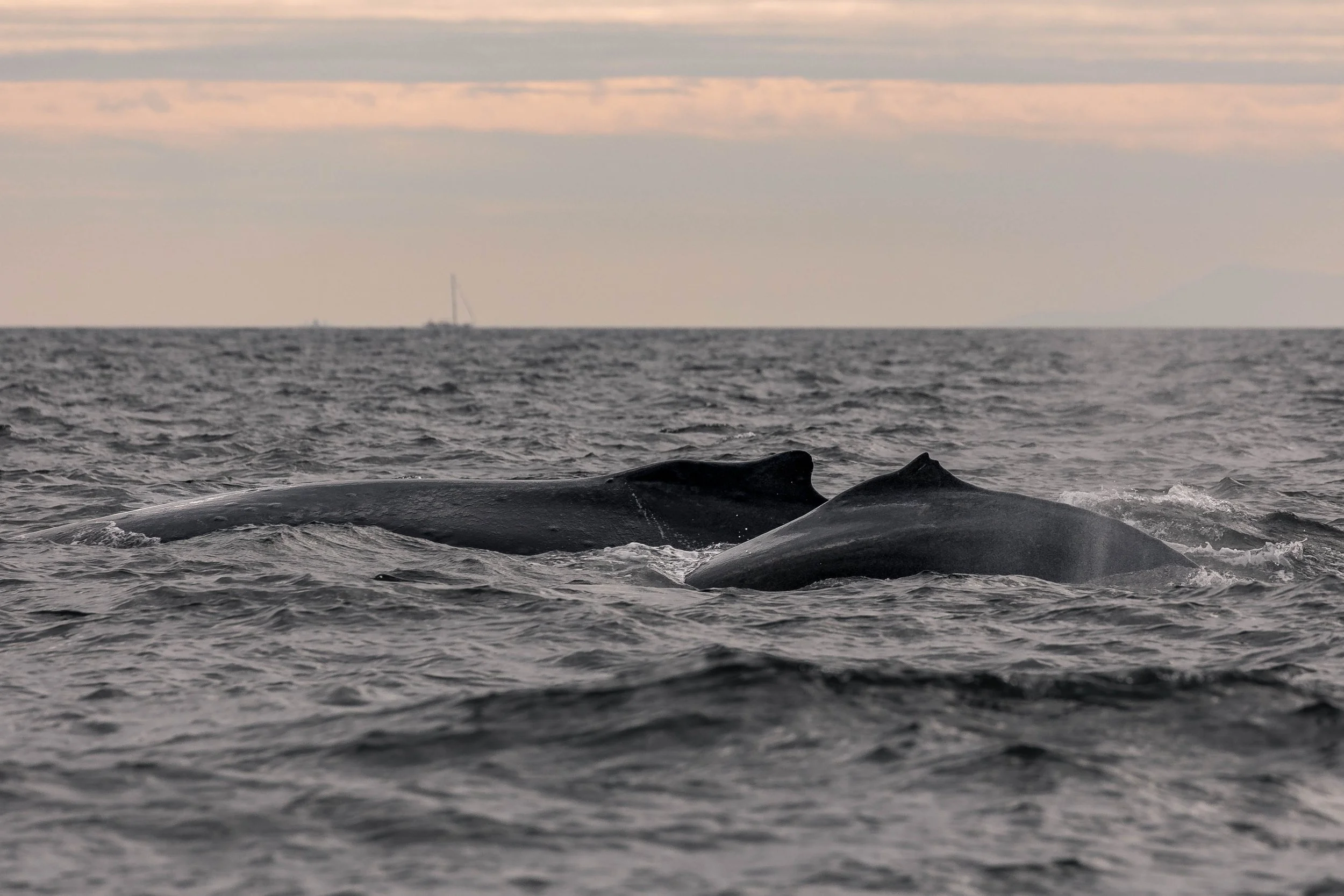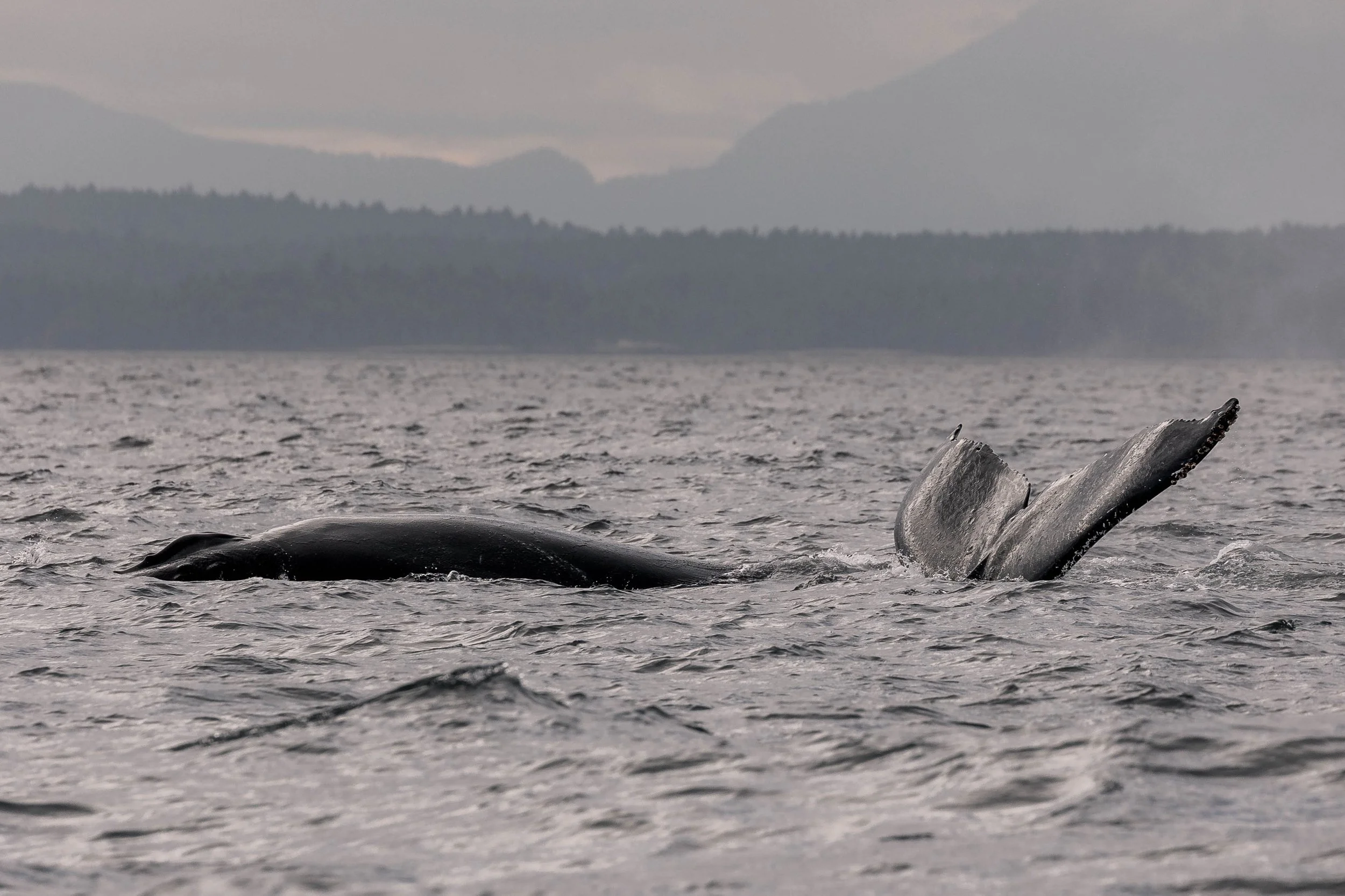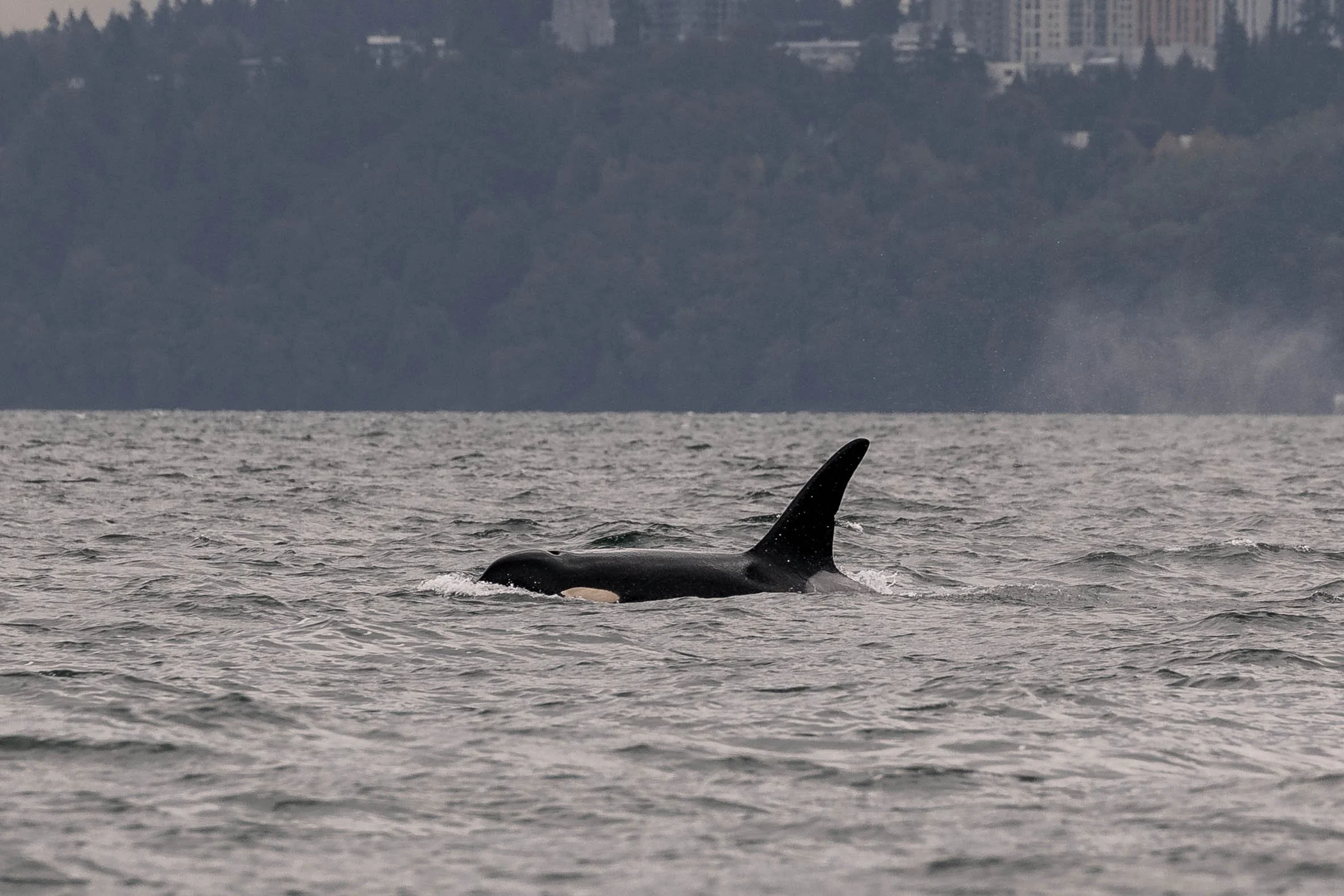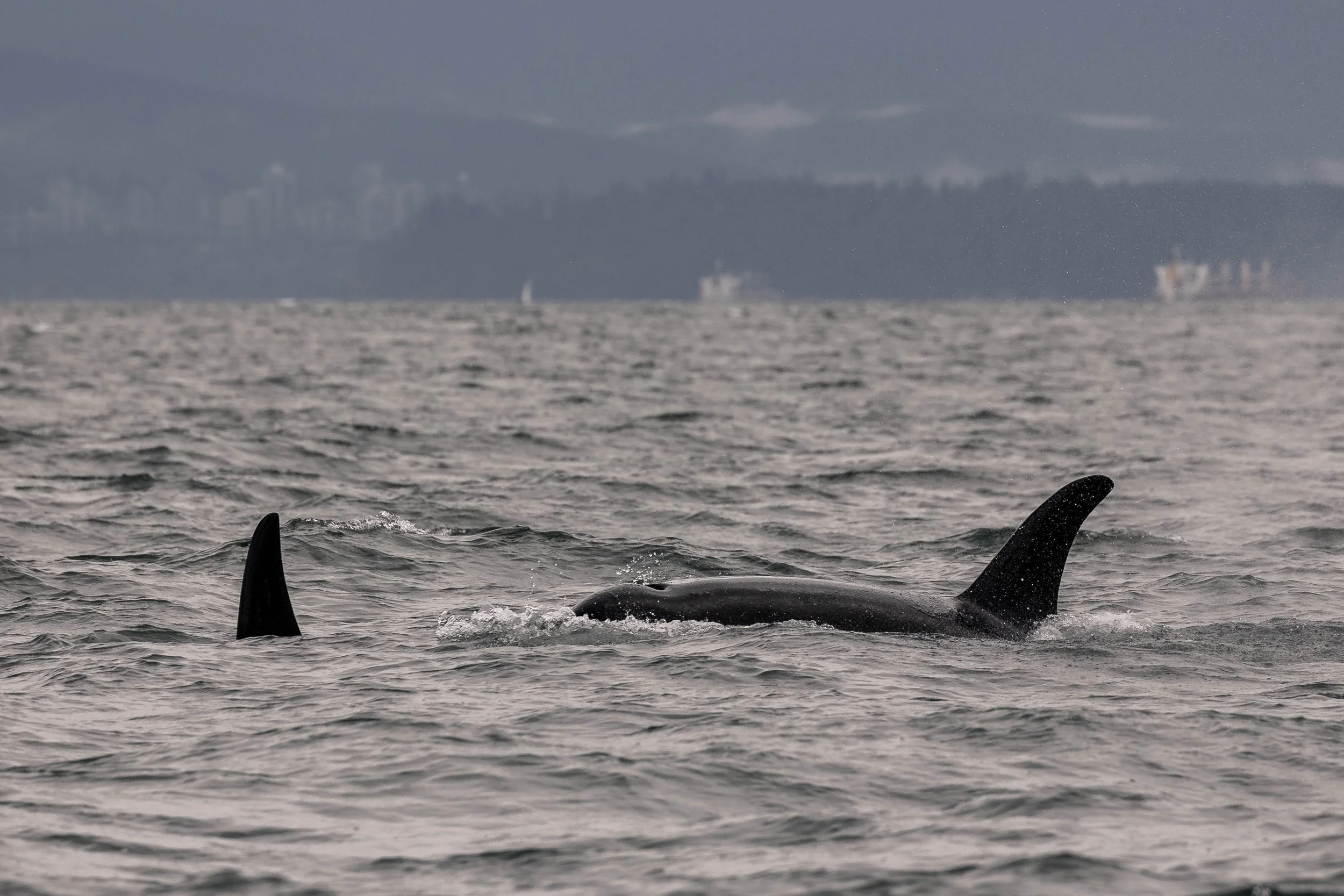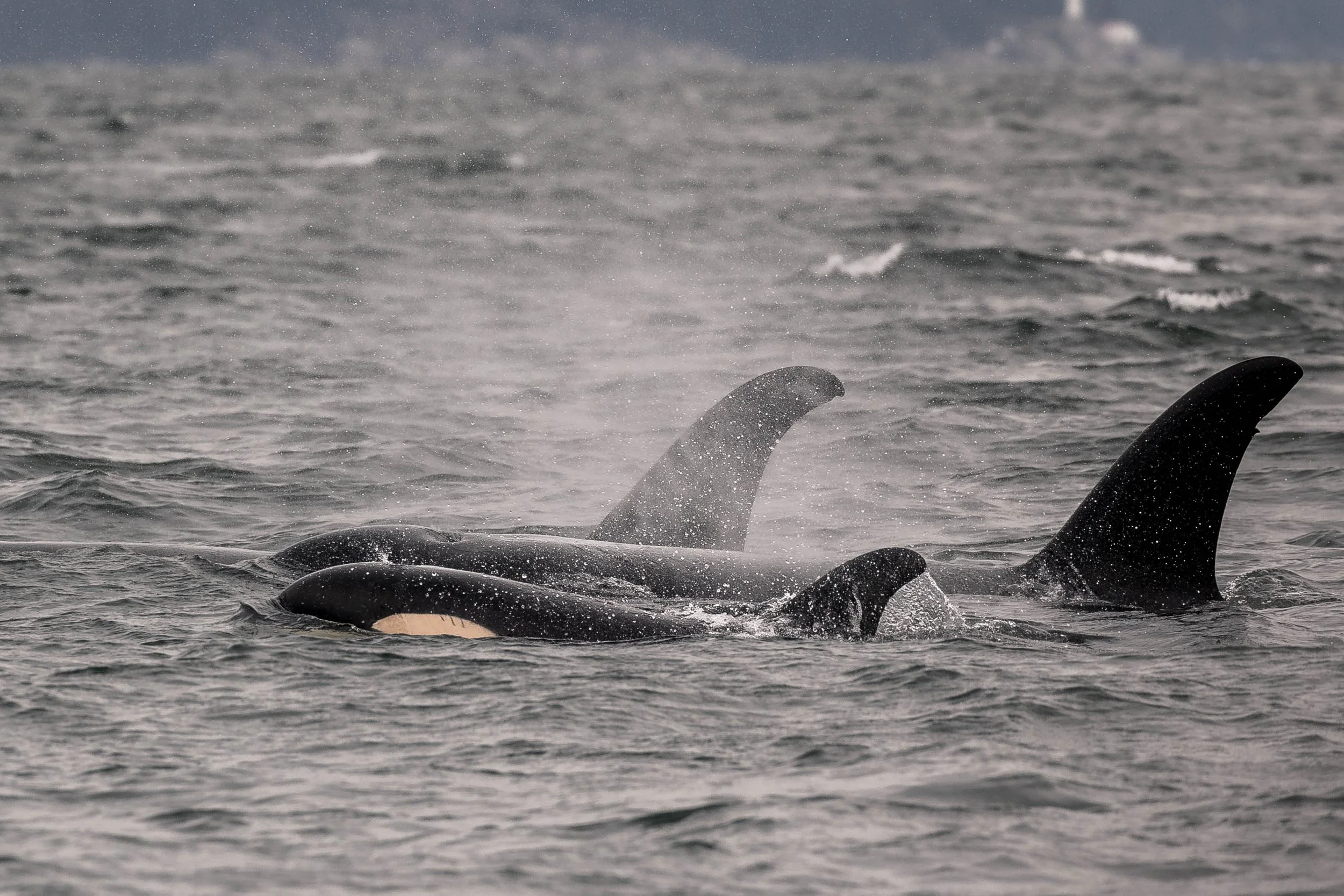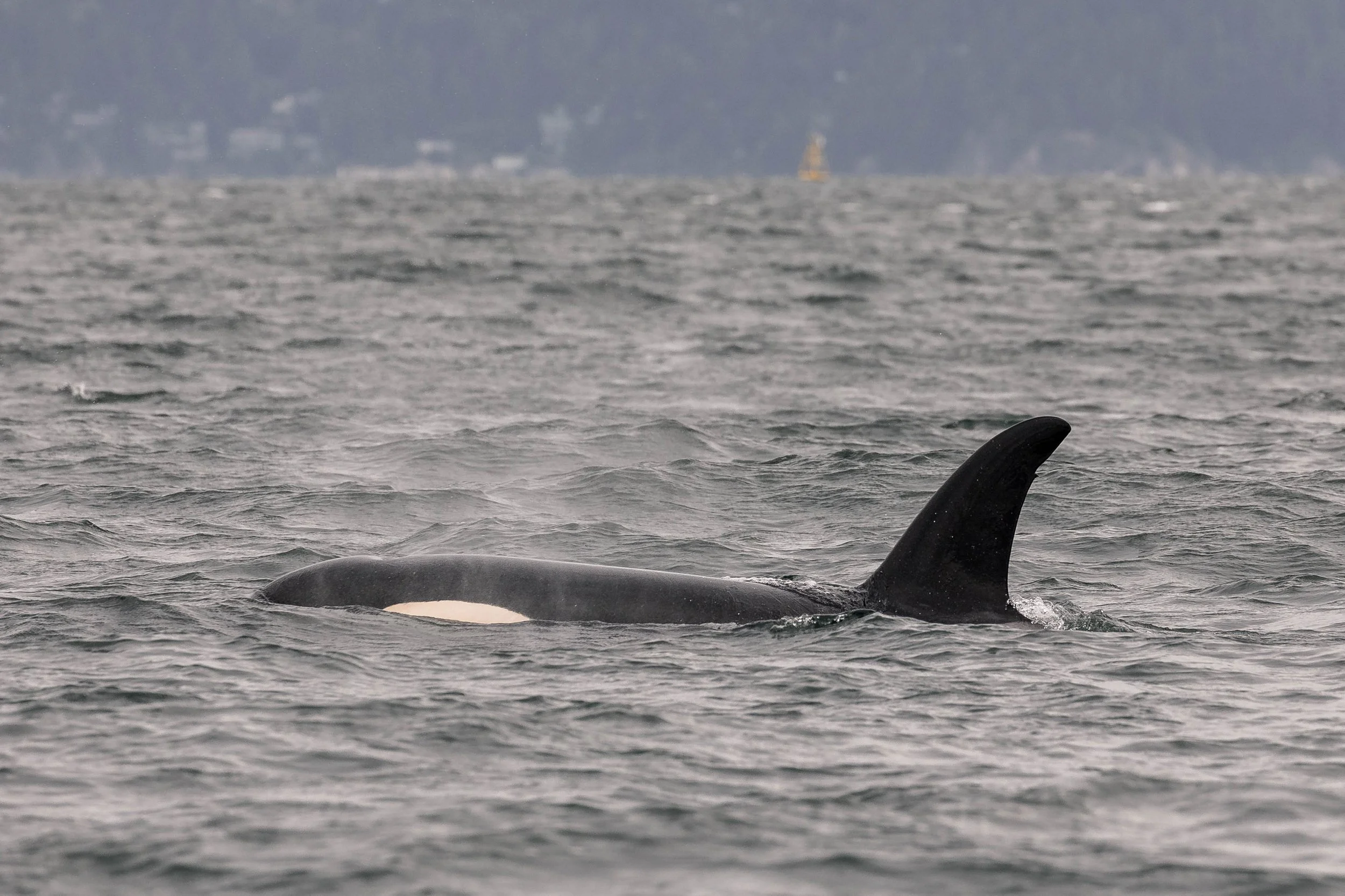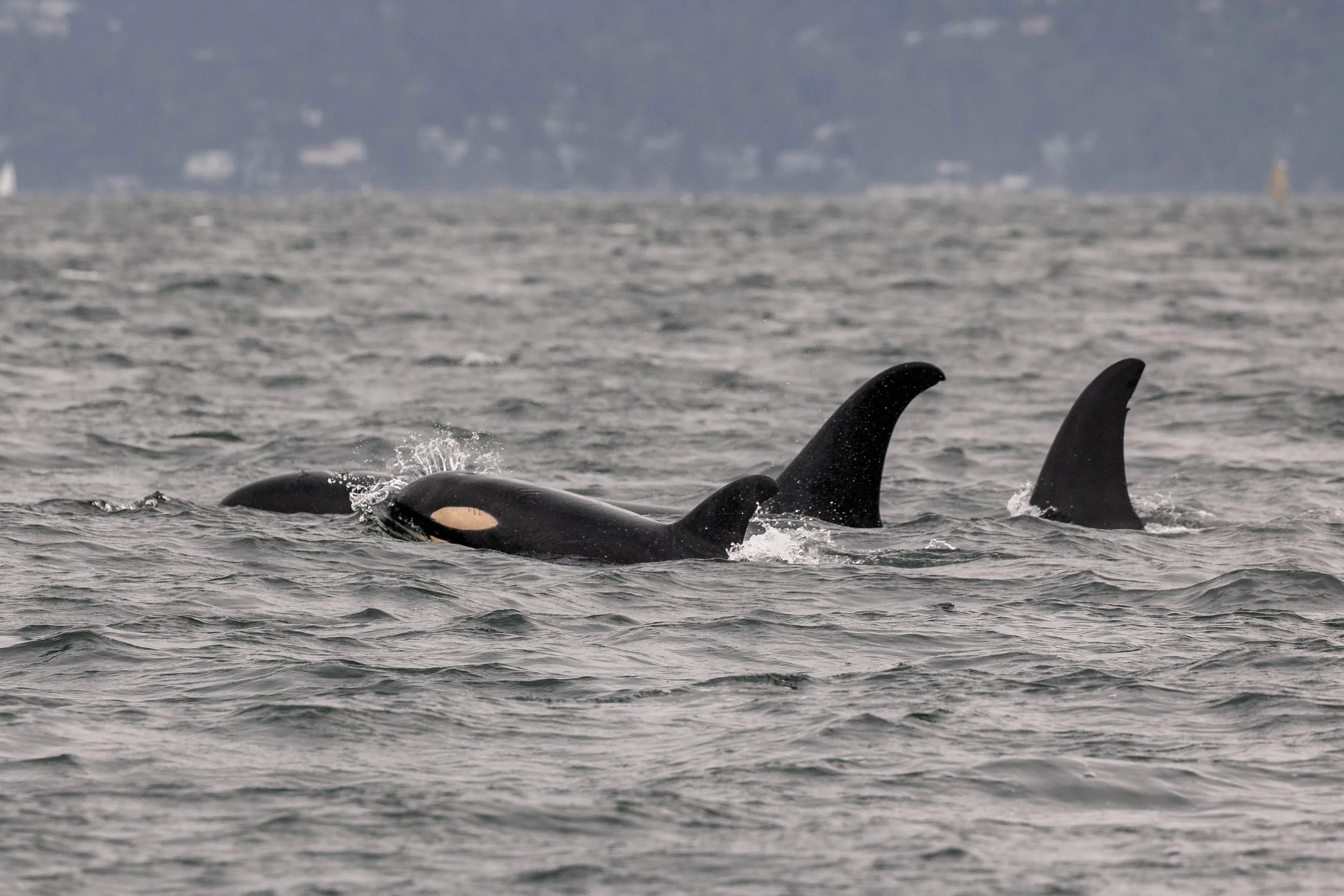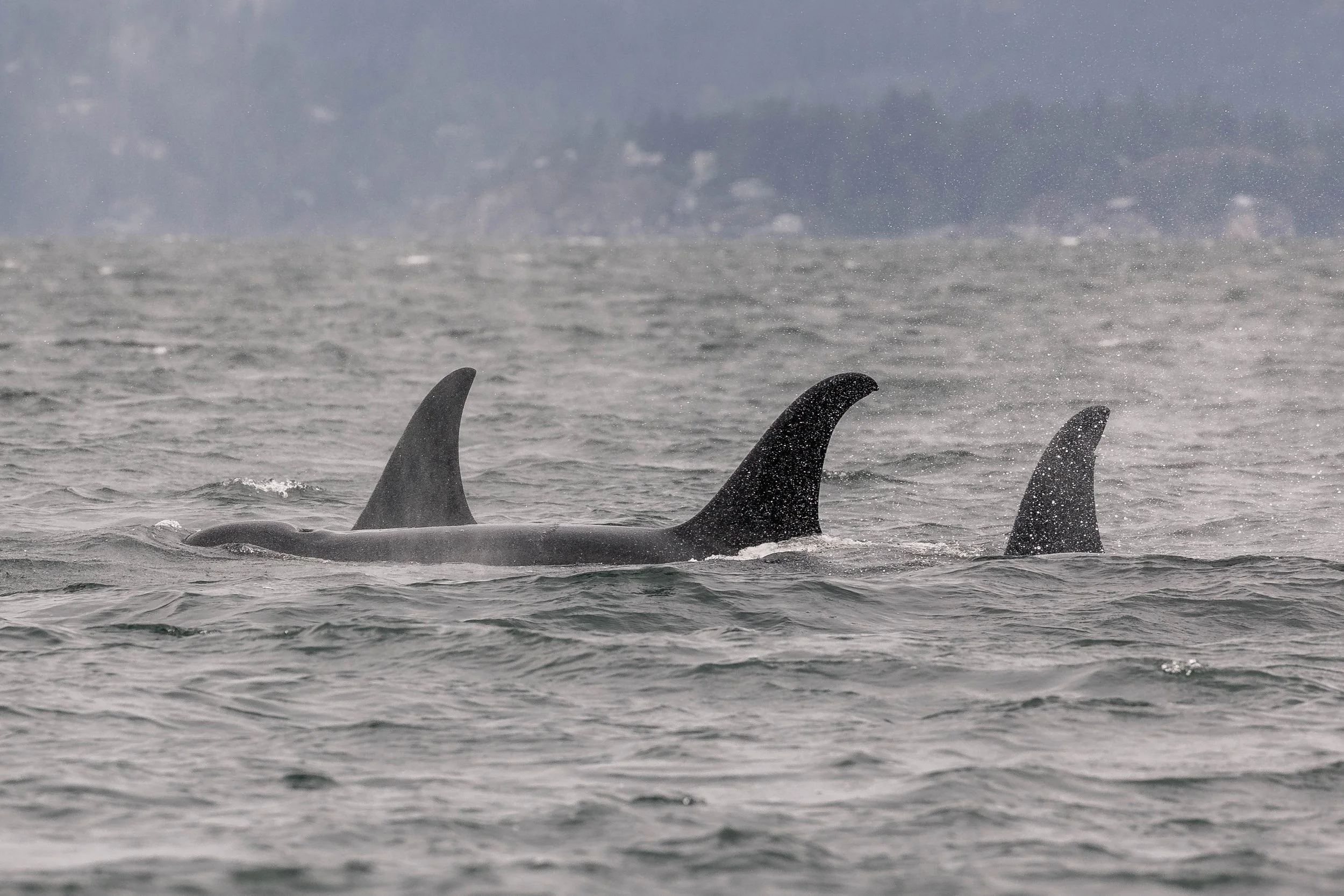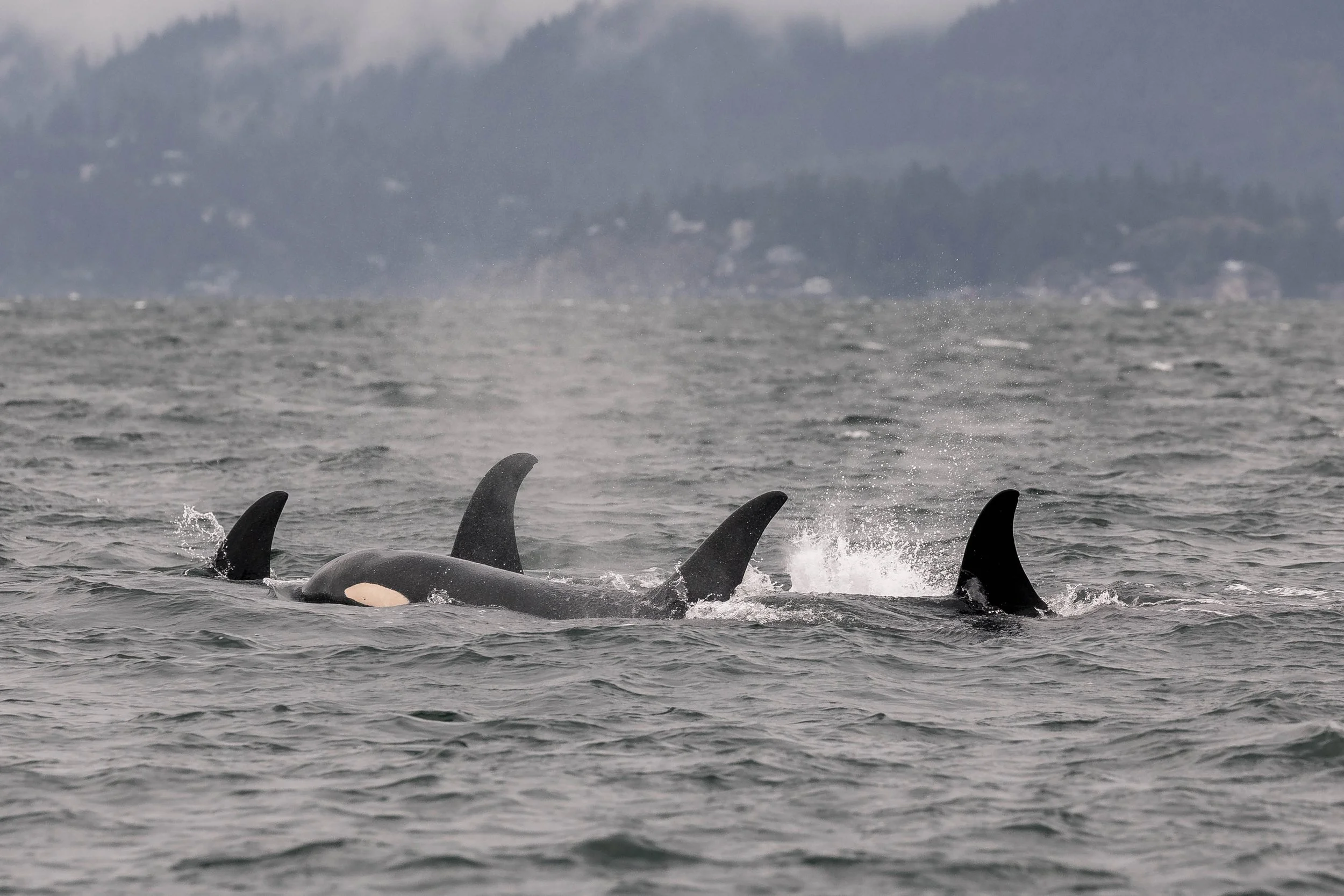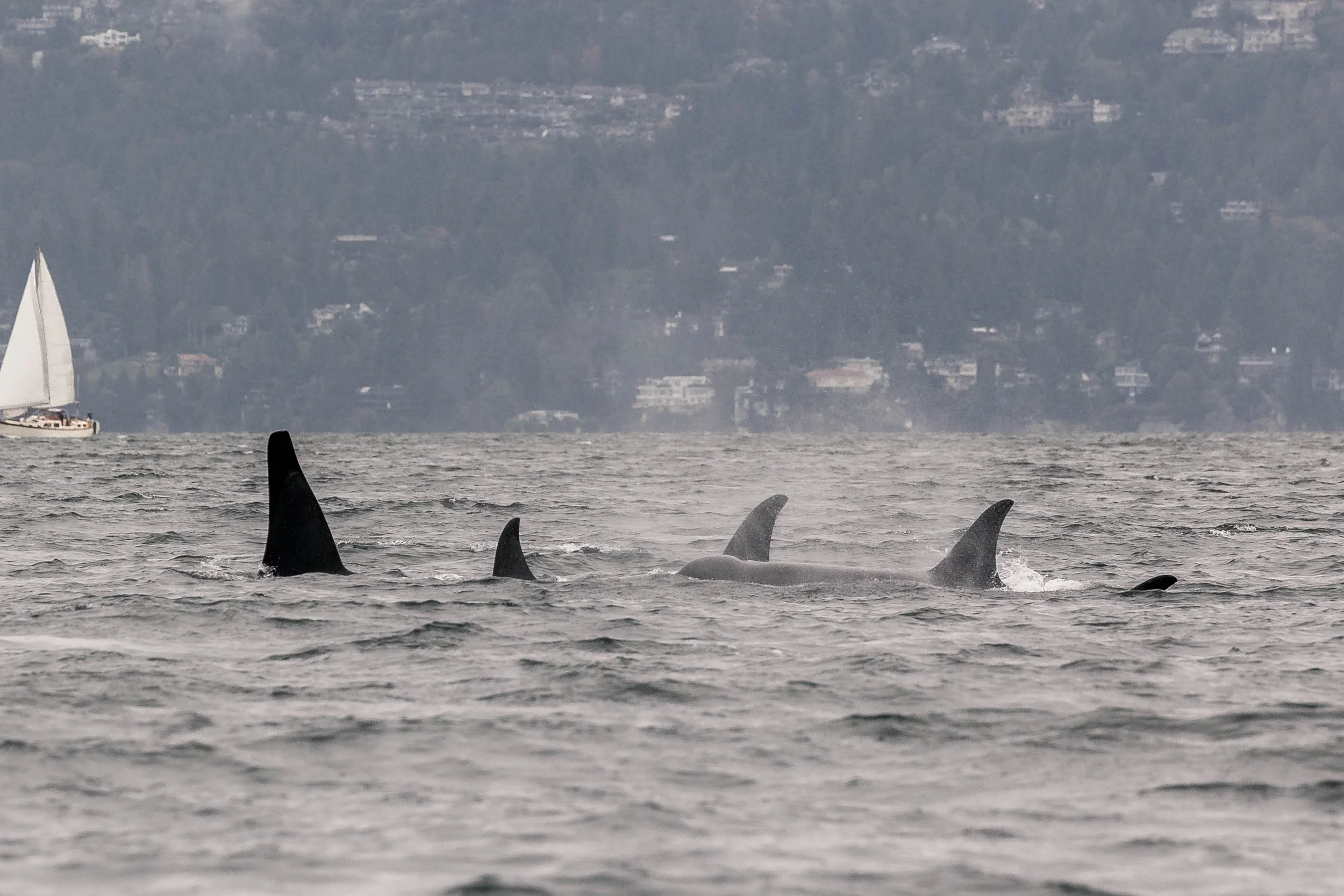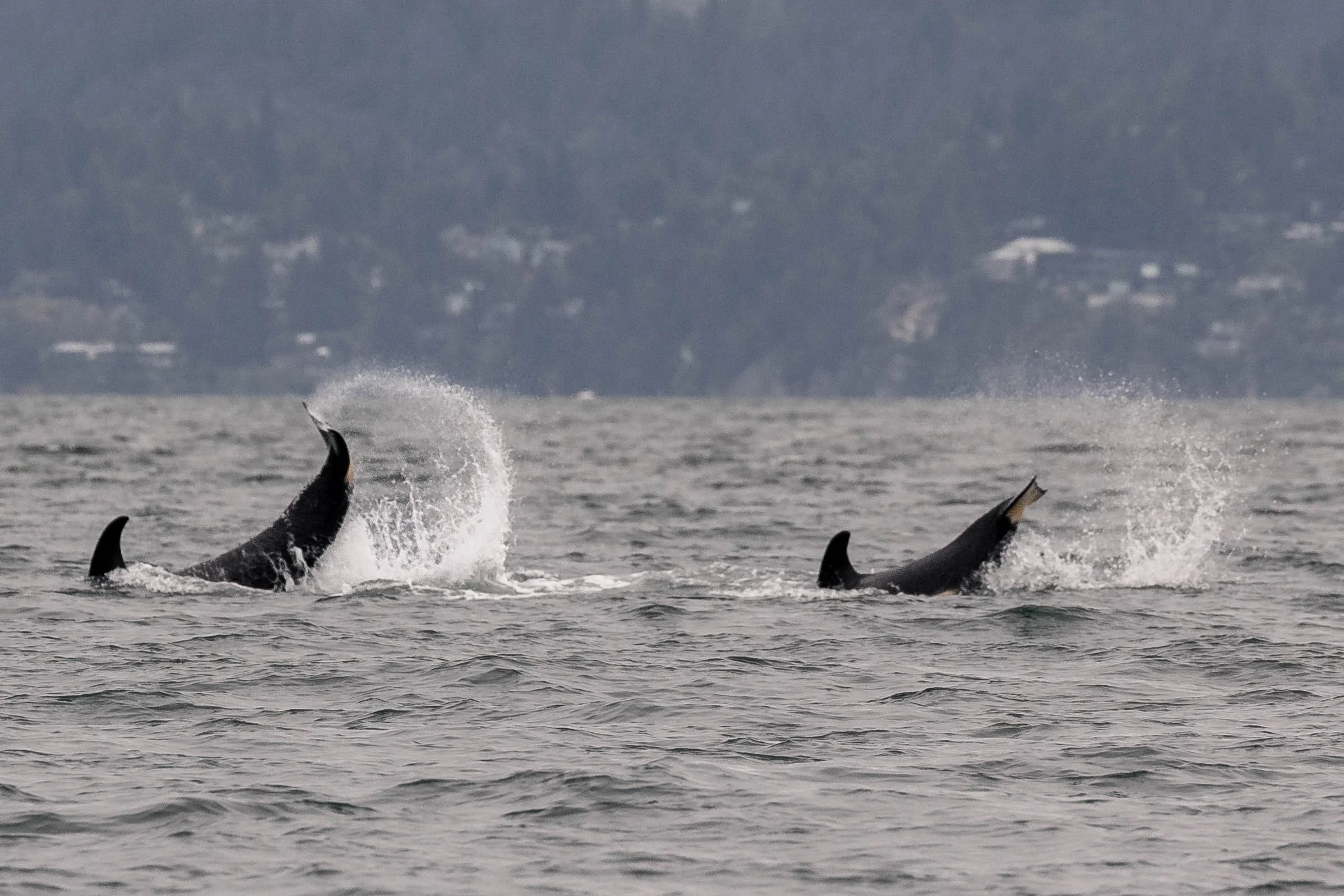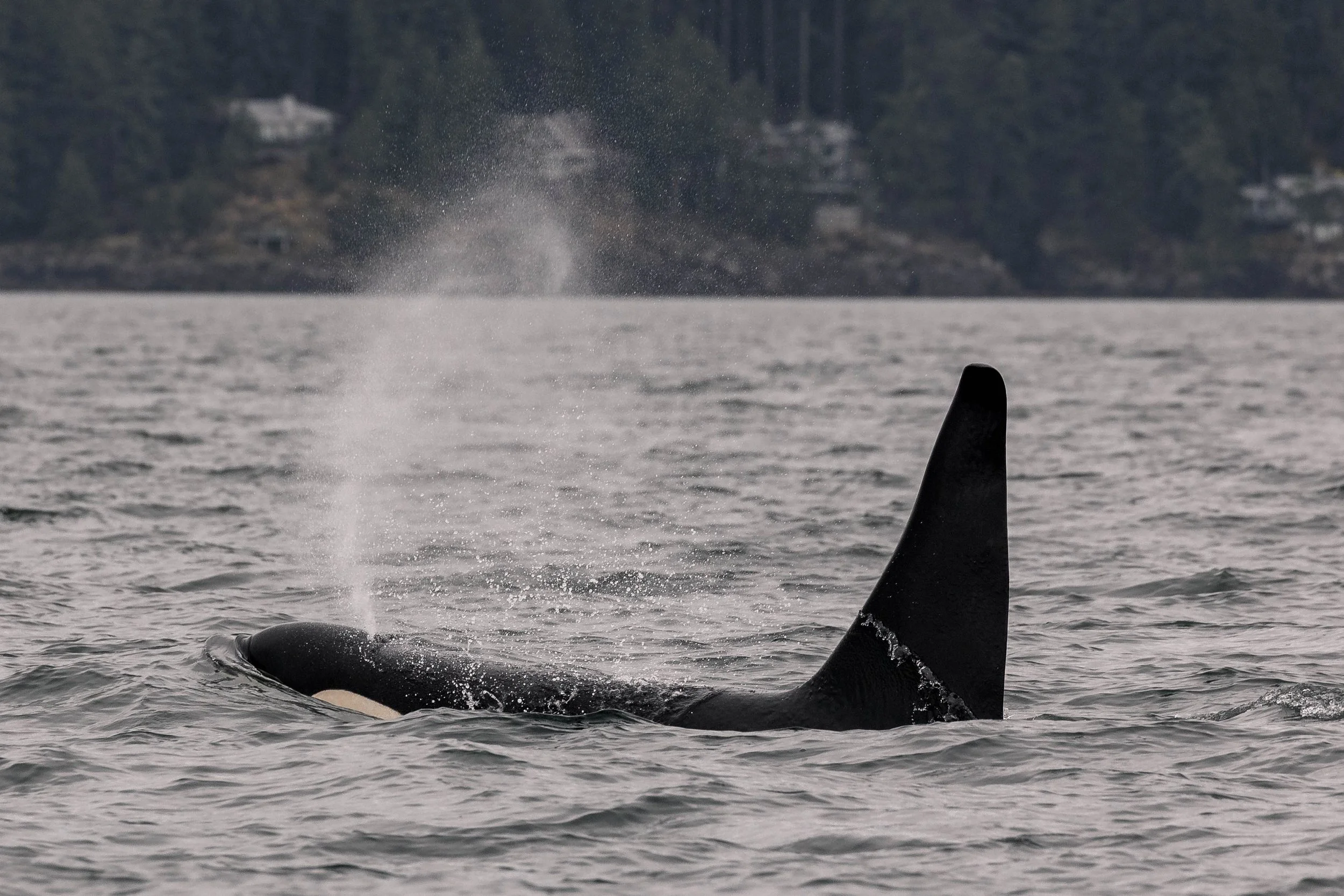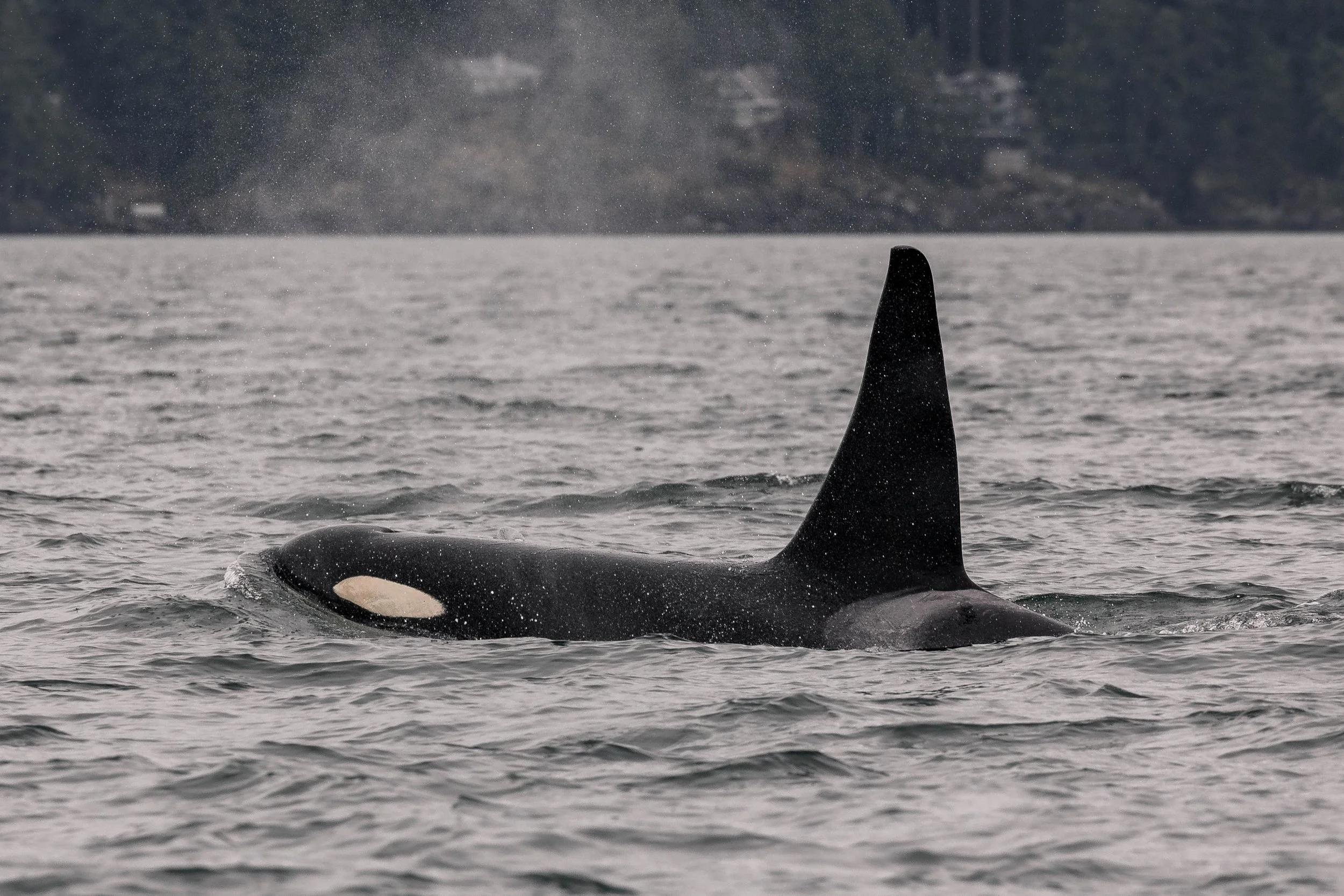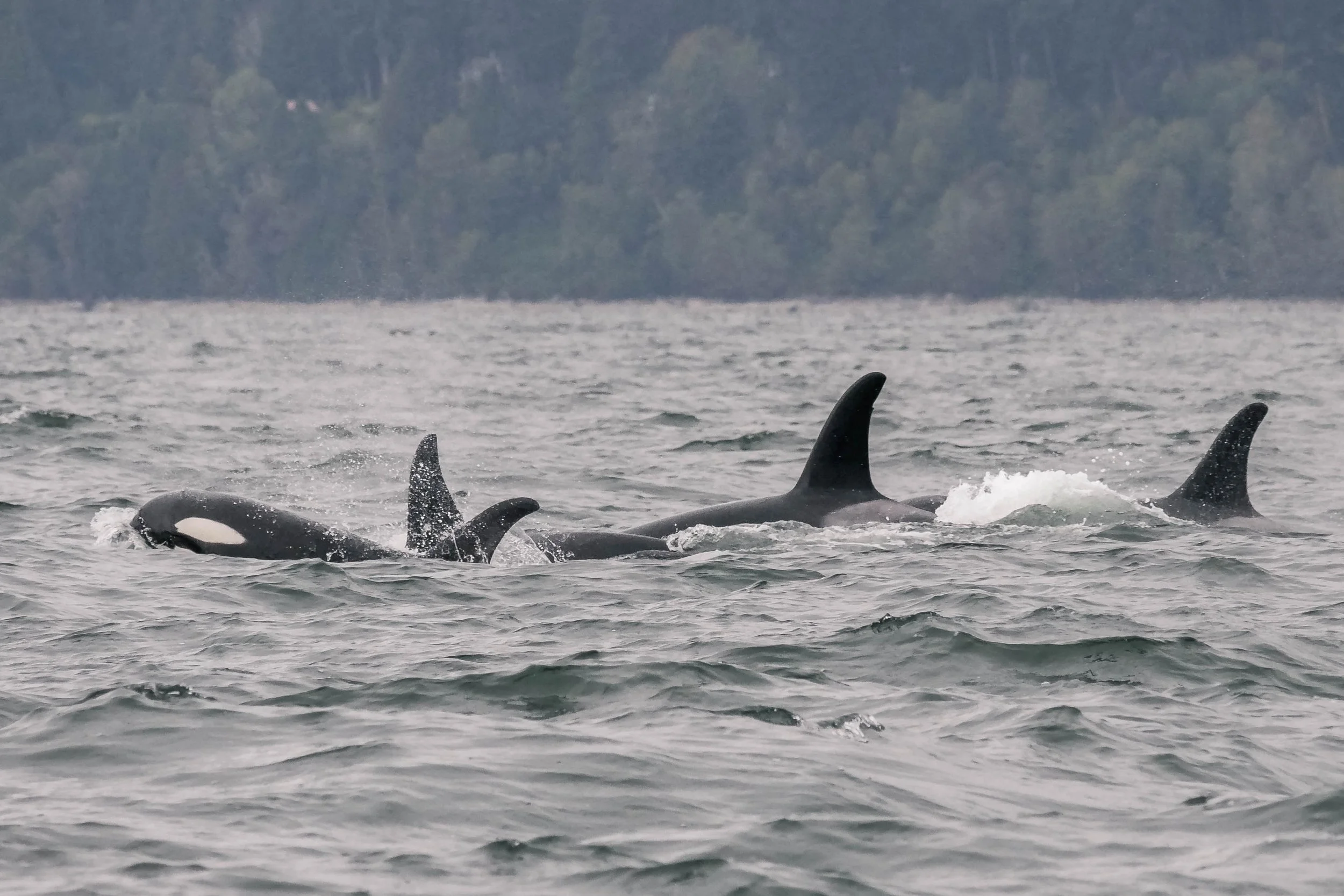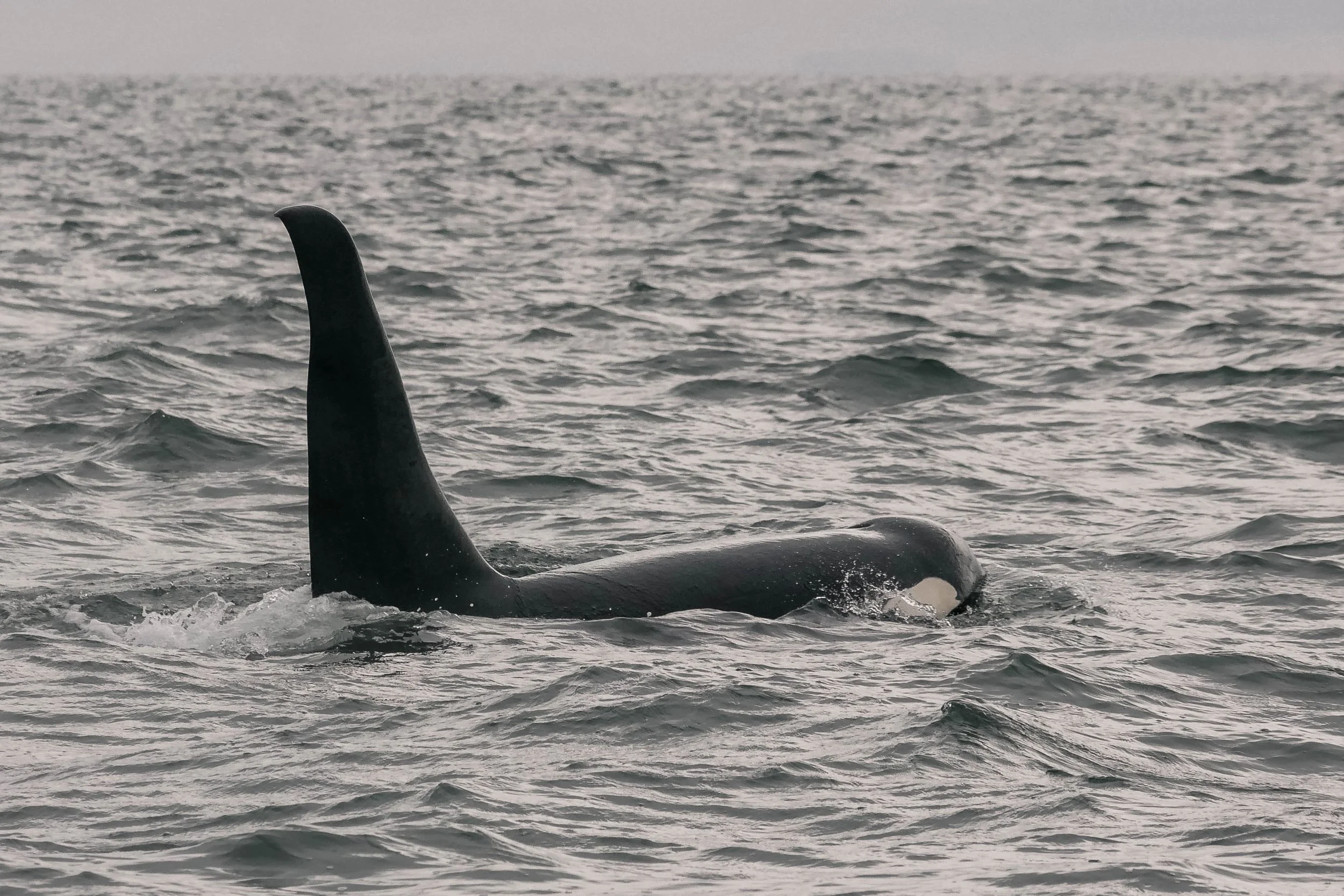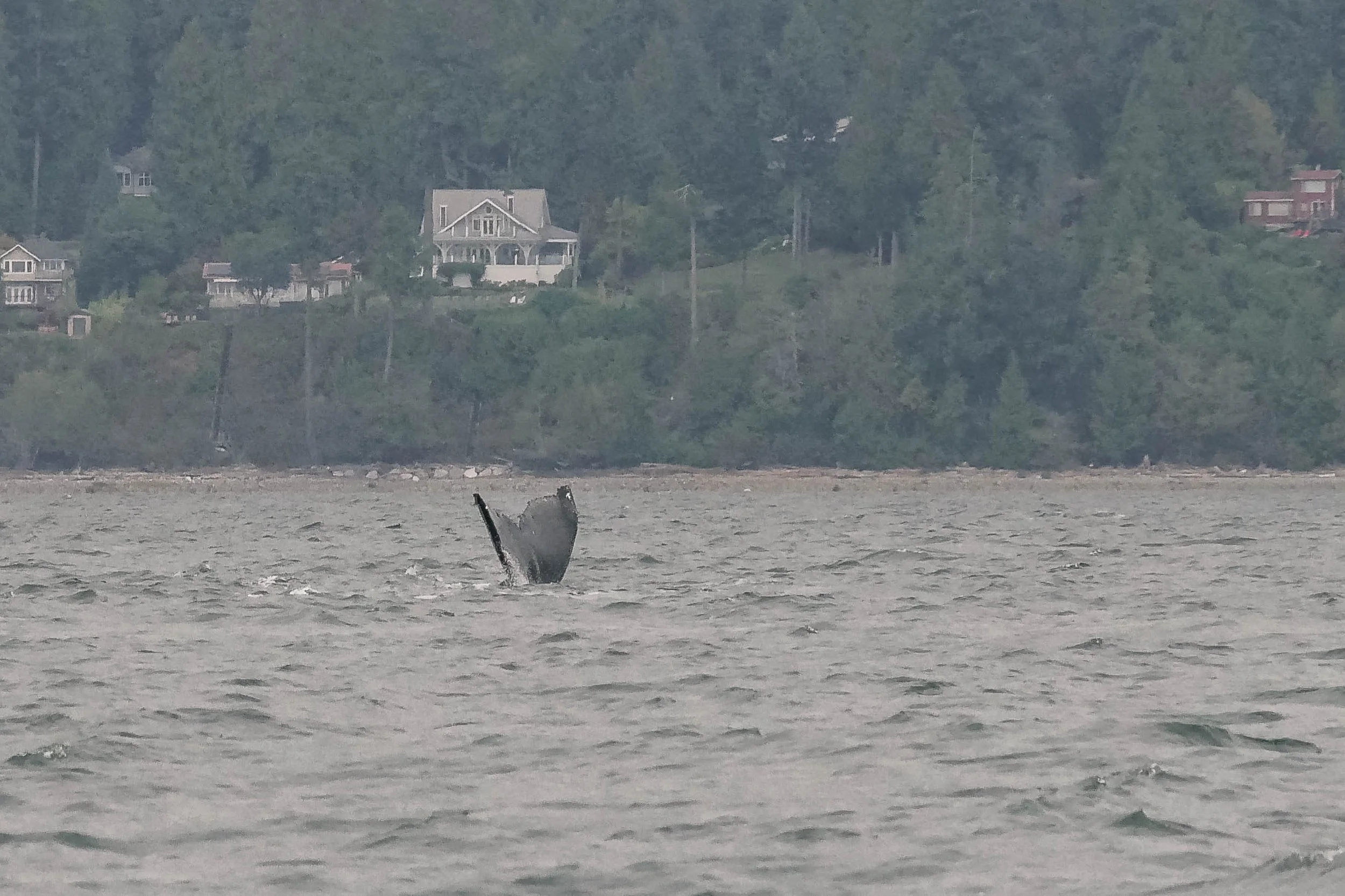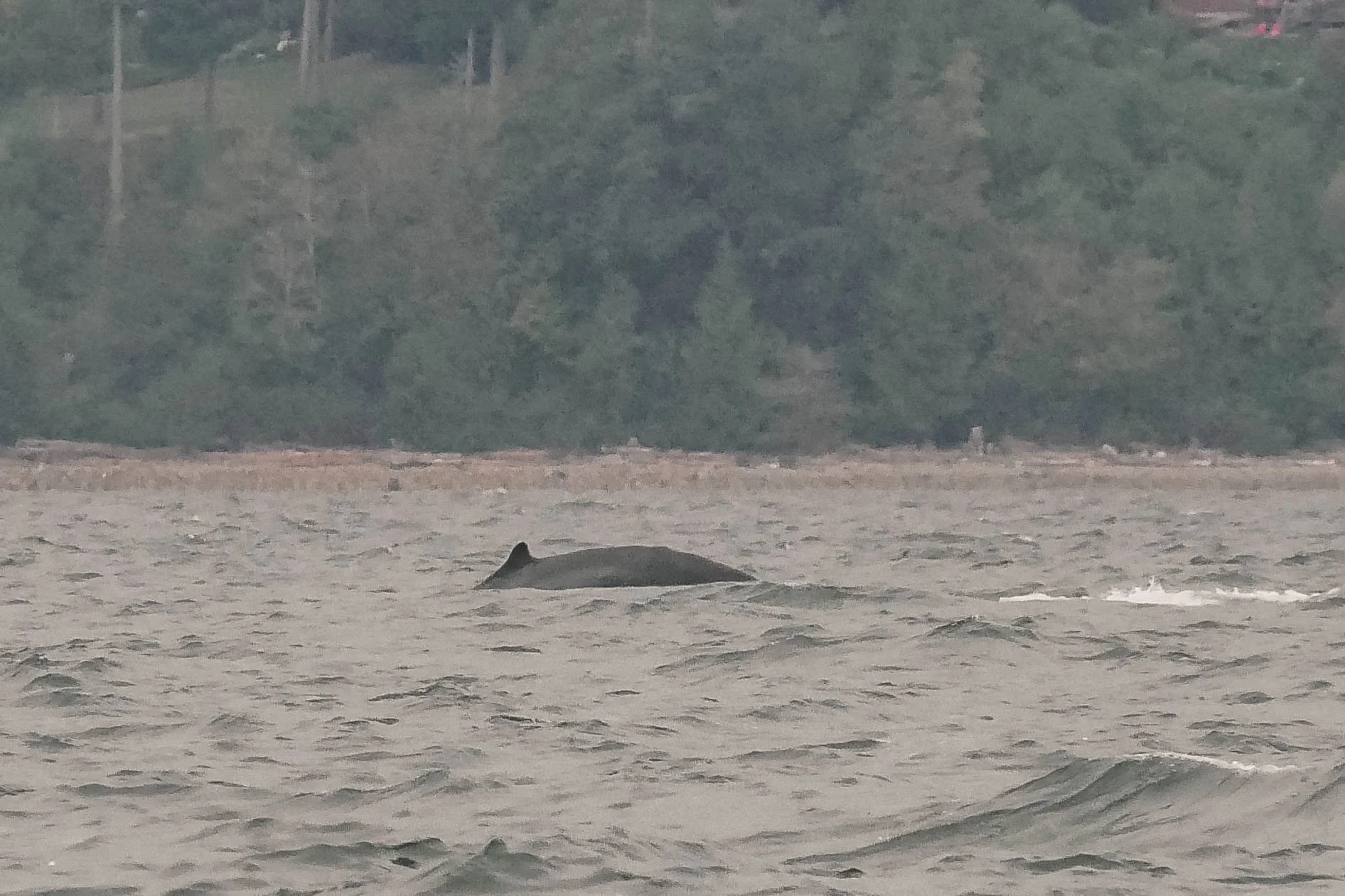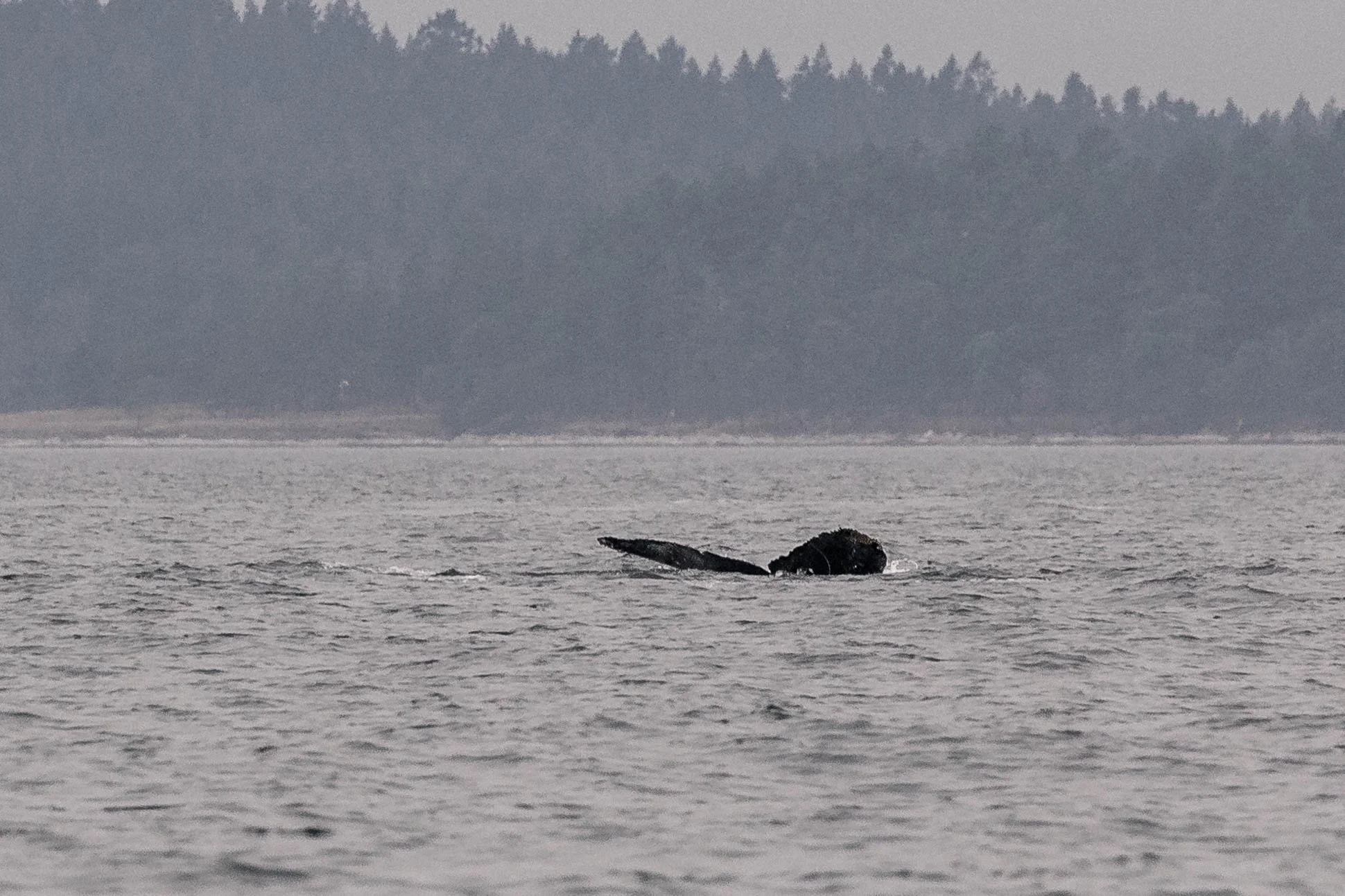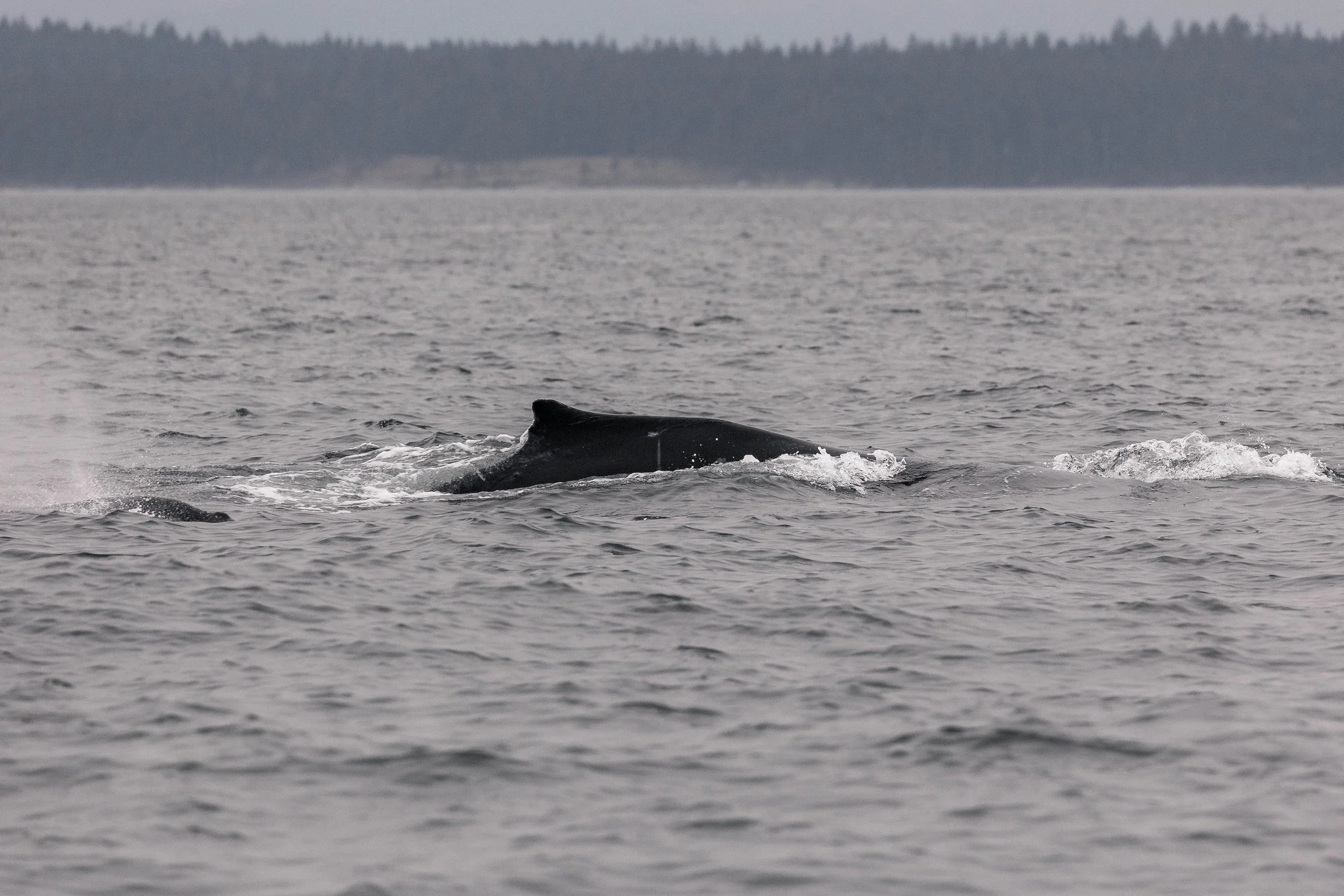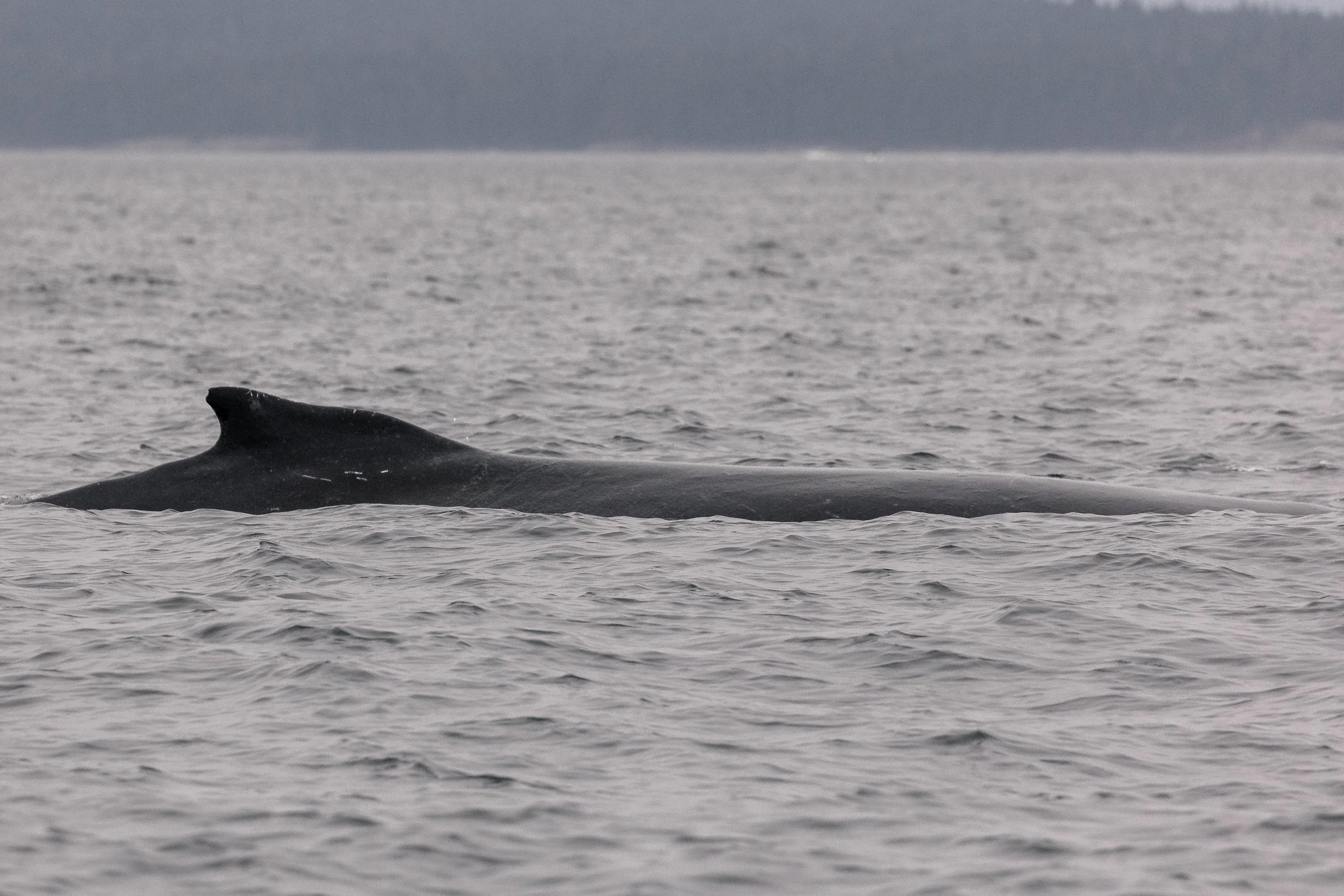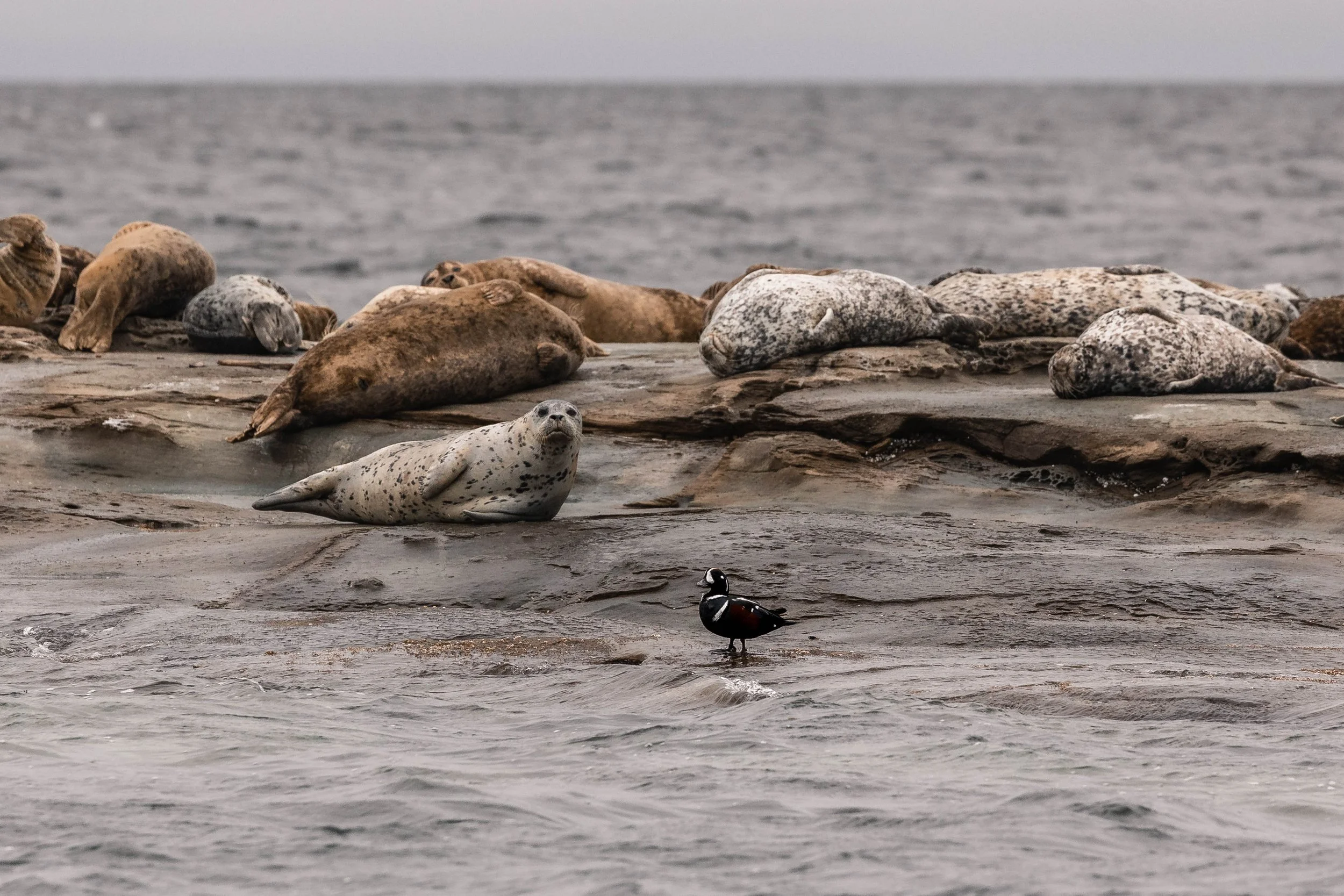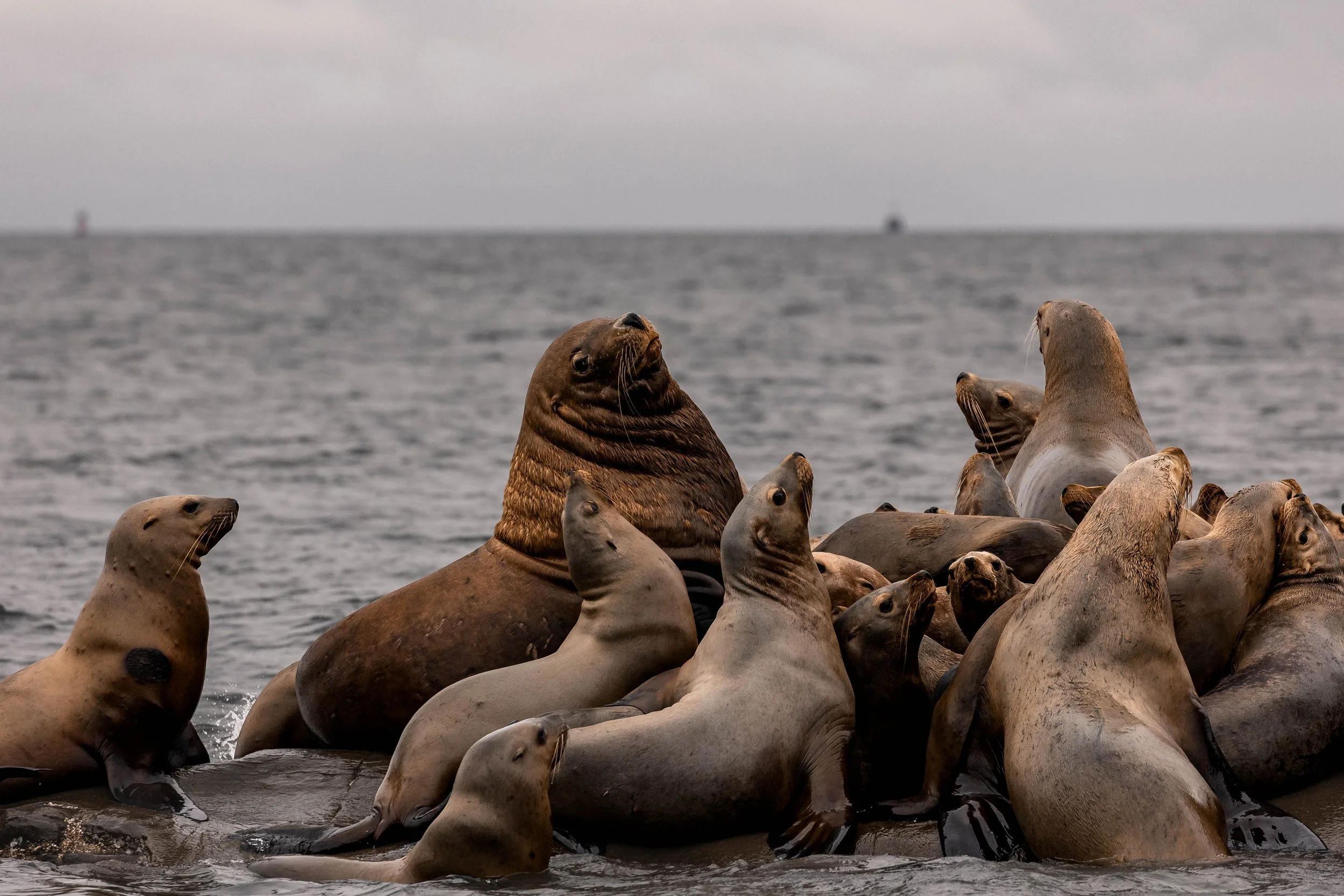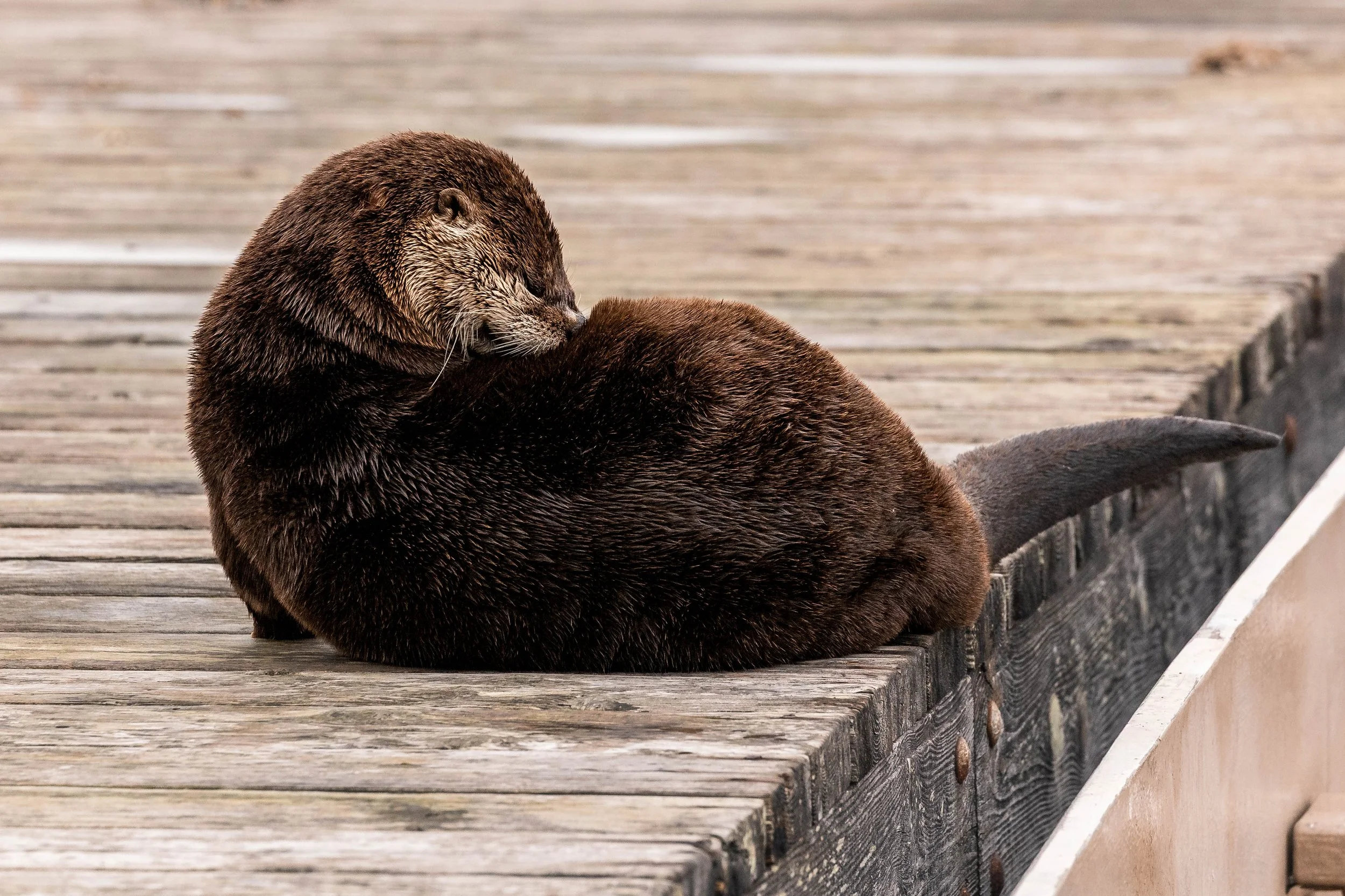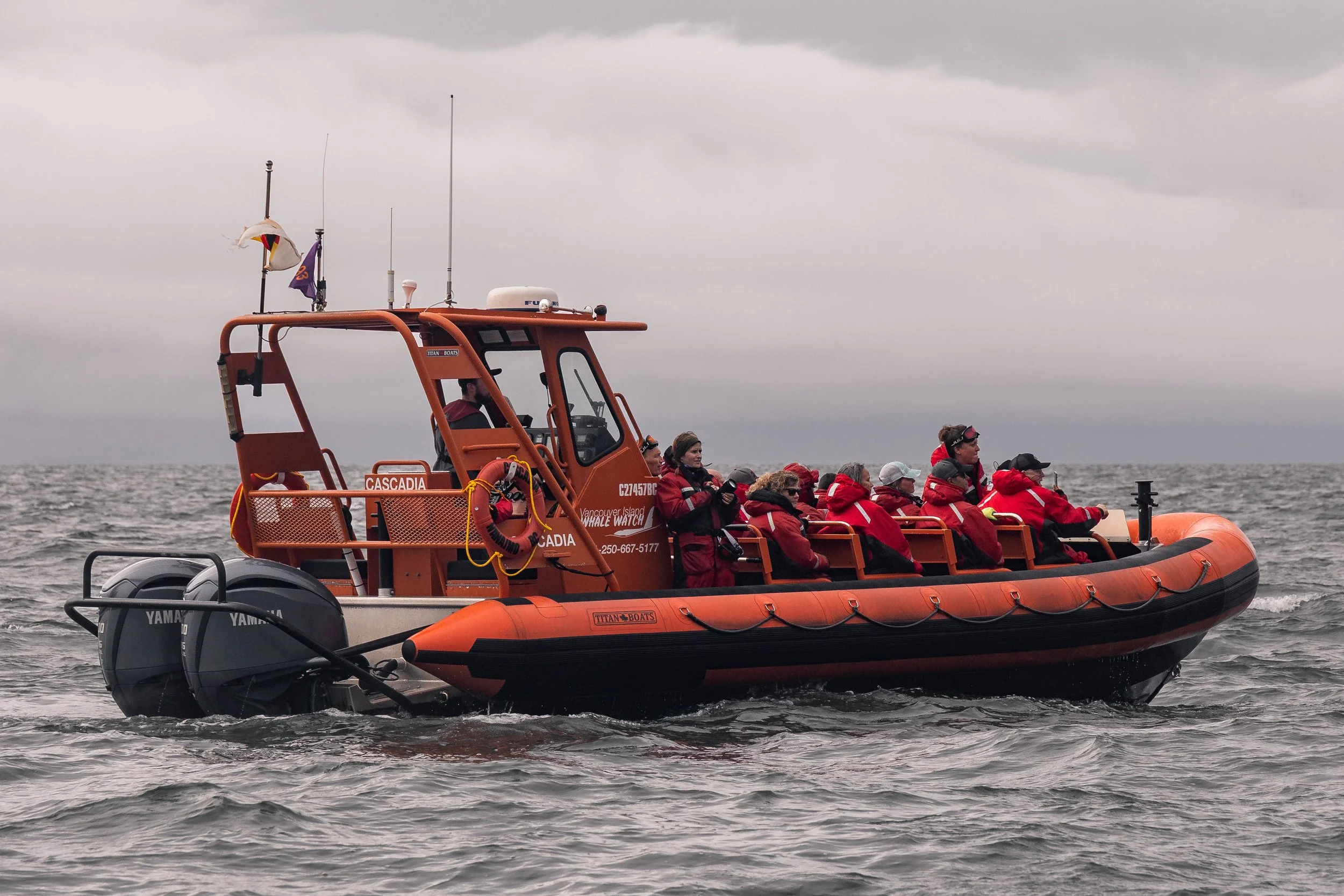September 27, 2025 - Northern Residents and a handful of Humpbacks
Every day brings new adventures! Today, with slightly staggered departure times, our semi-covered vessel Kula began the day’s exploration at 10:00 AM while our open vessels Cascadia and Keta pushed off around 12:30 PM.
Kula began searching around Gabriola Island, a hot spot for whale sightings this season. After a bit of peeking about, they found their first whales of the day - a pair of humpbacks leisurely diving and fluking. They were not being very cooperative for photo identification, as we usually rely on photos of the underside of their flukes to confirm who is who. Thankfully, the pair both sported quite unique dorsal fins, with the larger of the pair having a couple of bumps on their dorsal fin’s side, and the smaller of the two having a uniquely notched dorsal fin. With these fins, we confirmed that they were Ghost (BCX1333) and her 2025 calf (BCX1333 calf 2025). This is Ghost’s fourth confirmed calf, with her first three being nicknamed Shade (2019 calf), Wisp (2021 calf) and Specter (2023 calf) respectively. This new little one will likely also earn an equally spooky nickname once they grow up, to match the rest of the family. Interestingly, Ghost seems very cyclical with her calves, giving birth every odd year. If she continues that trend, we will likely see her and a new bouncy baby in 2027!
Ghost is a great example of the strong site fidelity humpbacks show towards their natal feeding grounds. Her newer two calves, Wisp and Specter, are regularly seen in the Salish Sea every year now. We hope that this new calf will also be a regular to the Salish Sea, so we can observe them growing and thriving!
We said our goodbyes to Ghost and her young calf and continued east, excited to continue the day’s trip. We had caught word of a sighting of orca off of the Sunshine Coast, and we were hoping to get there and see them soon. After crossing the Strait of Georgia, we made our way over to Bowen Island, situated in the mouth of Howe Sound. Once we approached, we caught sight of several dorsal fins rising high up out of the water. These dorsal fins were a bit different from our usual Transient (Bigg’s) orca dorsal fins, though, and that was because they were actually Northern Resident orca!
A25s
A61 Surge ♂ (1994)
A85 Cordero ♀ (2005)
A121 Twilight ♂ (2019)
A42s
A42 Sonora/Holly/Uma ♀ (1980)
A79 Current ♀ (2004)
A119 Venture ♀ (2018)
A135 (2024)
A88 Cameleon ♀ (2008)
A88 calf (2025)
A103 Albion (2013)
A114 Ashlar (2017)
A94 Mystery ♂ (2009)
The Northern Residents are always an exciting find, as they rarely travel south enough to be seen in our waters. The young members of the pod were spotted excitedly tail slapping and breaching while they travelled along and socialized.
“How can you tell the different types of orca apart?” is a very common question on our trips. Each different ecotype of orca has subtle differences in their appearances. In general, Northern Residents tend to have gently curved dorsal fins with rounded tips. Resident dorsal fins may also lean forward on the body. Transient dorsal fins tend to be straighter and more pointy. Saddlepatches, or the greyish white area behind the dorsal fin, also play a key role in telling the ecotypes apart. Transient saddlepatches are a solid colour, whereas Northern Resident saddlepatches may appear ‘open’ or have a black patch in the middle of them. While these differences may seem very minute, from an evolutionary perspective, these two kinds of whales are vastly different! Evolving separately from each other hundreds of thousands of years ago, similar appearances are some of the only things the Transients and Northern Residents share. With wildly different diets, calls, family structures, hunting techniques, and ranges, scientists have proposed to separate these two genetically distinct groups into entirely different species!
“Well, if the Transient and Northern Residents are so different, where does that put the Southern Residents?” Southern and Northern Residents, unlike Transients, are very similar. They feed on the same kinds of fish, and they have the same larger family structures… so why are the Northern Residents (300+ individuals) doing so much better population-wise compared to the Southern Residents (~75 individuals)? This is a multifaceted issue, but one of the main factors is the difference in their home ranges. While there is some overlap, the Southern Residents frequent waters to the south that have high levels of ship traffic, whereas the northern waters, where the Northern Residents can be found, tend to be a bit quieter. Noise pollution in the seas that Resident orca hunt in can cause the animals to either hunt less or give up on pursuing prey. With quieter waters, the Northern Residents experience less noise pollution in their hunting grounds. Other issues, including lack of prey abundance, also contribute greatly to the difference in the Southern vs Northern Residents’ success and population size.
As Cascadia and Keta departed from the dock and were making their way over to the Northern Residents, they stumbled on another pair of humpback whales! Similar to Ghost and her calf, these two were being quite fluke shy, with us only managing to catch one shallow fluke angle as one dove. Thankfully, they also sported very unique dorsal fins that we were able to use to confirm their IDs! These two were Coyote (BCX2484) and Sherwina (BCY0961).
Coyote has a distinct dorsal with a tiny chip out of the very tip of it. Sherwina’s dorsal fin has a large scoop out of the back edge. While Coyote did dive once with their tail out of the water, Sherwina continued to be tail shy. These two were likely travelling along and potentially feeding. We are quickly approaching the end of the humpback feeding season, so they are packing on as many pounds as they can before they depart our area within the next few weeks.
While the Northern Resident sighting was unique in itself, it became even more interesting when a small humpback whale was spotted close by! While we have not yet confirmed who they were, we will continue consulting our catalogues to hopefully learn who was interacting with the orca today.
We had had a very whale-filled day, but that wasn’t the end of our wildlife encounters for the trip! We ventured over to Stinky Rocks, an area aptly named for its odourous presence, where many of our Harbour Seals were hauled out, sleeping away. These small pinnipeds do not migrate and can be found along our shores and beaches year-round. In contrast, the large lumbering Steller Sea Lions nestled up on the rocks on the other side of Stinky Rocks are only here for around half of the year. During the summer, they migrate north, where they breed and give birth, before returning to our area once more as the weather begins to cool.
All photos today were taken by Marine Naturalists Hayleigh Hilbert, Desarae Poier, and Jordan Robinson. Please enjoy!
Ghost’s dorsal fin. Photo by Hayleigh Hilbert, 10:00 AM.
Ghost’s fluke. Photo by Hayleigh Hilbert, 10:00 AM.
Ghost (back) with her young calf (front). Photo by Hayleigh Hilbert, 10:00 AM.
Ghost and calf beginning to dive. Photo by Hayleigh Hilbert, 10:00 AM.
A94 Mystery travelling alone. Photo by Hayleigh Hilbert, 10:00 AM.
A88 Cameleon. Photo by Hayleigh Hilbert, 10:00 AM.
A79 Current, A88 calf 2025, and A103 Albion. Photo by Hayleigh Hilbert, 10:00 AM.
A103 Albion. Photo by Hayleigh Hilbert, 10:00 AM.
A88 calf 2025, A79 Current (back), and A103 Albion. Photo by Hayleigh Hilbert, 10:00 AM.
A42 Sonora/Holly and A85 Cordero. Photo by Hayleigh Hilbert, 10:00 AM.
A42 Sonora/Holly, A79 Current, and A103 Albion. Photo by Hayleigh Hilbert, 10:00 AM.
A42 Senora/Holly, A85 Cordero (front), A79 Current (back), and A114 Ashlar. Photo by Hayleigh Hilbert, 10:00 AM.
A42 Sonora/Holly and A114 Ashlar. Photo by Hayleigh Hilbert, 10:00 AM.
Breach for the sky! Photo by Hayleigh Hilbert, 10:00 AM.
Coming in for a landing! Photo by Hayleigh Hilbert, 10:00 AM.
A61 Surge, A85 Cordero, A103 Albion, and A42 Sonora/Holly. Photo by Hayleigh Hilbert, 10:00 AM.
Two of the young pod members, A135 and A88 calf 2025, tail slapping away! Photo by Hayleigh Hilbert, 10:00 AM.
A61 Surge with a beautiful blow. Photo by Hayleigh Hilbert, 10:00 AM.
A61 Surge with his eyepatch, dorsal fin, and saddlepatch all visible in the same shot. Photo by Hayleigh Hilbert, 10:00 AM.
A121 Twilight. Photo by Des Poier, 12:00 PM.
A121 Twilight, A103 Albion, and A119 Venture. Photo by Des Poier, 12:00 PM.
A61 Surge. Photo by Des Poier, 12:00 PM.
A61 Surge travelling. Photo by Des Poier, 12:00 PM.
The mystery humpback near the Northern Residents fluking. Photo by Des Poier, 12:00 PM.
The mystery humpback near the Northern Residents. Photo by Des Poier, 12:00 PM.
Coyote’s fluke. Photo by Hayleigh Hilbert, 10:00 AM.
Sherwina’s dorsal fin. Photo by Hayleigh Hilbert, 10:00 AM.
Coyote’s dorsal fin. Photo by Hayleigh Hilbert, 10:00 AM.
Harbour Seals and Gulls enjoying the calm waters around Stinky Rocks. Photo by Des Poier, 12:00 PM.
Another new species: a male Harlequin Duck! Photo by Hayleigh Hilbert, 10:00 AM.
Curious Harbour Seals watching us float by. Photo by Hayleigh Hilbert, 10:00 AM.
Regal Steller Sea Lions posturing on the rocks. Photo by Hayleigh Hilbert, 10:00 AM.
A large male Steller Sea Lion sits amongst the smaller ones. Photo by Hayleigh Hilbert, 10:00 AM.
Sitting on the rocks alone. Photo by Des Poier, 12:00 PM.
A River Otter grooming at the docks. Photo by Hayleigh Hilbert, 10:00 AM.
A Great Blue Heron wanders the docks. Photo by Jordan Robinson, 12:00 PM.
Our semi-covered vessel, Kula. Photo by Jordan Robinson, 12:00 PM.
Our open vessel, Cascadia. Photo by Jordan Robinson, 12:00 PM.



